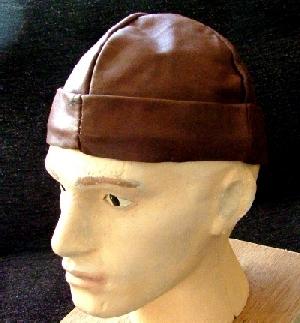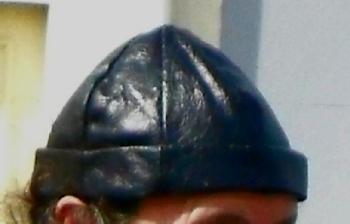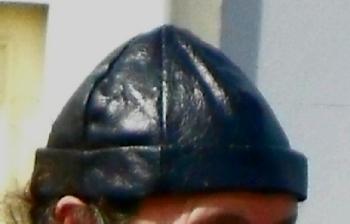-
Posts
5,931 -
Joined
Content Type
Profiles
Forums
Events
Blogs
Gallery
Everything posted by fredk
-
For the quantities you want I would ask Le Prevo Leather in Newcastle. They sell pre-cut leather items and do leather fabrication as well as selling raw leather. They might work with you in cutting the discs and supplying them to you. No harm in asking. . . . http://www.leprevo.co.uk/
-

Is there a cheaper alternative to a bell knife skiver?
fredk replied to williaty's topic in Leather Machinery
If you study the photos the machine comes with a set of rollers so just the edge can be skived and in the spiel it says; quote; Equipped with 4 different sizes of rollers to choose from, in order to achieve different peeling width. end quote Don't wait on me; it could be months before I get around to using it PS; some of these use a peculiar type of blade, some, like mine, use the cheaper and easier to get blades as used in box cutters [aka Stanley knives] -
Nothing that I've come across Over the last couple of years I've been lightly researching what 1800s Westerner's wore; items such as chaps, shirts, trousers, vests. I've not come across any single book on either these together or individually. I have now accumulated about 30 books on various aspects of Western life, simply to get the photos within those books. One thing I've not done this time but I did do when researching Medieval clothing and accessories was to contact museums. I contacted them for brochures and postcard pictures of items in their collections. In a few cases the museums had books produced by archaeologists, very specialised books and very expensive [3 books from Dublin museum were over £50 each] and not normally available to anyone outside of academia. Thus I'd advise you to contact the very numerous museums throughout the Mid-West and ask for copies of their hand-out brochures and postcard photos of items. If you go to 'True West' website they often have details on some of the museums and what their collections consist.
-

Is there a cheaper alternative to a bell knife skiver?
fredk replied to williaty's topic in Leather Machinery
I bought one of these recently: https://www.ebay.co.uk/itm/Sewing-Leather-Splitter-Edge-Skiving-Tool-Leather-Craft-Device-Paring-Cutter-/254213890096?hash=item3b30542030 1. Mine cost £26 2. I've not had the opportunity to use it yet 3. Allegedly they need careful setting up to work correctly but once set up they work great -
interesting piece of furniture mmmm, my thumbs are itchy, I'm getting the feeling that this was made in the 1930s/early part of 1940s. Looks like the wood was scumbled, probably a cheap pine or white wood underneath. Very nice piece for all that anyhows
-
I've wet moulded in thickness from 0.5mm to about 4mm. I reckon, maybe 3mm, or 2.5mm, 2mm at the thinnest for your requirement. The heavier the item, the thicker the leather. Recently I moulded a moblie phone holster for myself. I think the main moulded leather was about 2mm and it got a lining of 1mm leather.
-

What tools do I need to recreate this design by hand?
fredk replied to Alexis1234's topic in How Do I Do That?
I use a Chinese company, thru ebay, but I'm not sure they could do this one. I mostly get binary stamps made. I think this is one 3D printing would win on -

What tools do I need to recreate this design by hand?
fredk replied to Alexis1234's topic in How Do I Do That?
tbh, I'd go the whole hog and get a brass stamp made for this. One stamp, used with hammer or press, will cost less than the tools needed plus it'll be quicker to reproduce in the small size and multiple copies. Where I get my brass stamps cut this would cost about £10. Either a brass stamp or a 3D printed one just some thoughts on it -

Dying pre-existing colored leather that is not veg tanned?
fredk replied to JC2019's topic in How Do I Do That?
I cut thru the lacquer coat with cellulose thinners. This usually removes some of the dye as well. On occasion I have left it partially dyed, then put fresh resolene on to seal it. It was done for a customer who wanted a 'well used' look to the item. Other times I have re-dyed in dark brown or black, then sealed that with resolene These hats were made out of chrome-tanned, pre-dyed upholstery leather. The brown hat on the left is untreated, the black one was done as said above; -
yes. make sure to use a top quality glue and ensure all areas are well and truly coated, especially the edges. Maybe use a brayer to press the two pieces together.
-
In N.I. a name beginning with X has that letter pronounced as EX not as Zee. Thus Xena is Exena, Xavier is Ex-aavi-eer, not Zav-vier. Is it the same in France? H and Th have their own ways of pronunciation here as well
-
If, If, it suits your needs, go for it. What is a drive to get what you require? Decent roads, plenty of rest places, a tankful of motion-lotion. . . . In my reckoning; If I can drive there and back inside 24 hours, then its 'local', thus all of the island of Hibernia and most of Scotland is 'local' to me
-

USA potential new tariffs against China
fredk replied to chrisash's topic in All About Us and Off Topic
aye, I've always found the same. Whenever I needed something made in the US, or for US companies, it was often very much cheaper and sometimes quicker to obtain it from a US retailer than a UK based US supplier eg. camera lens, made in Korea for a US company. about £1500 in the UK, imported from Honest Abe in New York, including s & h and all UK taxes £350. Delivery from Honest Abe; 4 days, from UK supplier estimated at 3 months. UK supplier was a US based professional photographic dealer for whom the lens was made. -
Well, no-one has jumped in to answer you Is that light spot just lacking dye or is the leather worn away as well. What I would do is; wash the area down with cellulose/lacquer thinners. Do an area well beyond that which needs doing. Then dampen the leather and apply coats of thinned dye until the area reaches the density of the rest. Let that dry thoroughly, buff up then apply some coats of a thinned sealant. Start just doing the fixed patch, then after a few coats extend the coverage bit by bit over the old areas. When that is dry and looks well rub in some good leather feed as the cellulose thinners will have removed oils from the leather which the feed will replace. It'll take a few days, maybe a week to do properly.
-
1. Take a wet rag and really buff over the part you've already dyed. Use a light coloured cloth. Rub hard. If dye comes off your deglazer hasn't done its job 2. I use meths and water together to dilute resolene. Either just water or just meths will do, sometimes I just use water. 3. Yes, I do up to about 5 coats of thinned resolene. Sometimes just two or three is enough. Only if I want a matt finish will I wipe over with a rag wetted with meths. Meths is methylated spirits; a wood alcohol. In the UK it is purple coloured and usually sold by chemists shops 4. You'll not need to do very much. If it gets wet, just hang up in an area where slightly warm air can circulate around it to dry it. Don't leave it inside a car where the sun will bear down on it and overheat it. Maybe once a year wipe it over with a good brand of leather cleaner/conditioner
-

How long did it take you to buy a sewing machine? And a press?
fredk replied to JC2019's topic in Leatherwork Conversation
Yes, they sell sets of letter stamps. They range from about 3/8 inches high to about 1 inch high. They are mostly upper case letters [capitals] but sometimes they do matching lower case letters. The range and availability comes and goes. eg. I got a set of upper case letters from Tandy but the lower case had been long discontinued - I found a set in a US dealer's old stock heres an example; https://www.tandyleather.eu/en/product/craftool-standard-alphabet-sets -

How long did it take you to buy a sewing machine? And a press?
fredk replied to JC2019's topic in Leatherwork Conversation
1. 18 years. I only got one to meet a customer's requirements. That job has been on hold for a few years now so I've not yet used the s/m. Now I've ended up with 5 of the durned things! 2. Press; 17 years. Only got one for to be quiet. I live in a ground floor flat [apartment] Up to then I could hammer stamp during the day whilst neighbours were at work but a change means they're more at home during the day and don't like my hammering -
Now I have a cup of tea in ma hawn All points; I use Resolene, and or SuperSheene now These hats were made of pieces of upholstery leather which had been pre-dyed and lacquered. The pieces were different shades of brown. I prepped the leather by giving it a surface wash of cellulose thinners, then dyed it black and then sealed with several coats of resolene. It is fairly rain proof. Note that its not possible to make leather totally waterproof. I have sold quite a number of these hats in the past. No dye comes off, no water stains after rain. The insides of the hat are not sealed so the leather can breathe or be treated. Initially the resolene stiffened the leather but a bit of time working it in the hands returned it so suppleness. Many coats of resolene can give the item a gloss finish, as can be seen in the photo on right. Up to about 4 or 5 coats of resolene thinned 1:1 will seal the leather but only be just starting to give it a gloss finish. To make this matt I wipe it over with a rag wetted with meths alcohol. You can buy Resolene either from Tandy or try on ebay I would check that you Angelus Dye Prep/Deglazer has really worked. I find that many do not work as they should thats why I use straight cellulose thinners for de-glazing and prep
-
I doubt that the threads originally used were cotton but perhaps more likely linen. If you want to replace with traditional thread, waxed linen or the hemp is what I'd use. I've found that even the best cotton thread is unsuitable for sewing and joining leather. My preference for traditional is waxed linen
-
Not everyone on this site is on 24 / 7. You need to give some time, more than just a day, for folks to come along and give a reply if they have anything to offer edited to add; it would help if you give your location in your 'profile'. We have members from all over this wee planet earth. Knowledge of where you are will help with answers
-
As the OP asked his question over 4 years ago I reckon he got the waterproofing done But just to point out; there is a vast difference between canauba wax and carnauba cream. The cream is water soluble so will not waterproof for very long. Carnauba wax is very hard and will, if melted into the leather, waterproof [aka make it water resistant] for a some time. Usually carnauba wax is mixed with beeswax to lower its melting temperature and its hardness. A carnauba/beeswax mix is easier to apply and will last just as long. @paloma : do not worry about getting the right words or language. This forum has members from all over the world and most of us on here allow for the fact that not everyone has 'English' as a first language. I also allow that sometimes what someone writes on the forum comes across not how they meant it to sound. I put this through google translate twice; ne vous inquiétez pas pour obtenir les bons mots ou la bonne langue. Ce forum a des membres du monde entier et la plupart d'entre nous comprenons que tout le monde n'a pas l'anglais comme première langue. Je permets également que, parfois, ce que quelqu'un écrit sur le forum ne soit pas ce qu'il voulait dire.
-
Basic answer; no. What you could do on the next one is to either use two layers of leather along and around the snap, with a hole in one layer so the snap is recessed, or use one thicker layer and skive around the snap place so its sort-of countersunk
-
I'm suggesting waist sizes; basically the strap from the buckle end to last hole. You'd want more for the strap folding around the buckle bar, a bit more along the back to hold the keeper on if you don't use a buckle with a keeper, and then maybe 4 inches past the last hole. Thus a mans belt for waist size 38 inch to 46 inches would be: 2 inches [on back] + 46 [from buckle to last hole] + 4 inches = 52 inches [roughly] Suggestion; for craft fairs, make long belts but don't punch the holes. Do that on site as a bespoke service. Keep a note book to note down what sizes you had to punch for. Then for future fairs you can make some belts pre-punched in some of the sizes.





